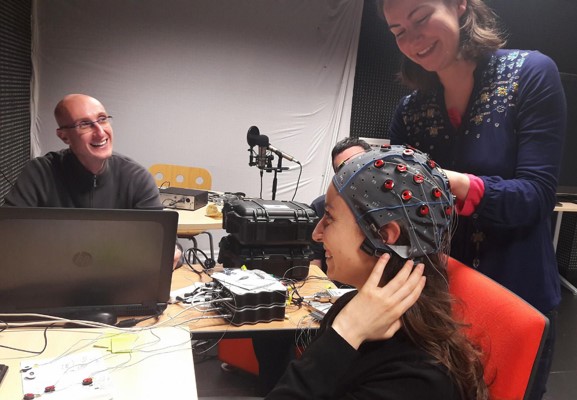Section: New Results
Understanding Brain-Computer Interfaces user Training
Participants: Léa Pillette, Camille Benaroch, Fabien Lotte
Computational models of BCI performance: Mental-Imagery based BCIs (MI-BCIs) use signals produced during mental imagery tasks to control the system. Current MI-BCIs are rather unreliable, which is due at least in part to the use of inappropriate user-training procedures. Understanding the processes underlying user-training by modelling it computationally could enable us to improve MI-BCI training protocols and adapt the latter to the profile of each user. Indeed, we developed theoretical and conceptual models of BCI performances suggesting that the users' profiles does impact their performances [12]. Our objective is to create a statistical/probabilistic model of training that could explain, if not predict, the learning rate and the performances of a BCI user over training time using user’s personality, skills, state and timing of the experiment. Preliminary analyses on previous data revealed positive correlations between MI-BCI performances and mental rotation scores among two of three different studies based on the same protocol [49]. This suggests that spatial abilities play a major role in MI-BCI users’ abilities to learn to perform MI tasks, which is consistent with the literature.
Modeling and measuring users' skills at MI-BCI control: Studying and improving the reliability issue of BCI requires the use of appropriate reliability metrics to quantify both the classification algorithm and the BCI user's performances. So far, Classification Accuracy (CA) is the typical metric used for both aspects. However, we argued that CA is a poor metric to study BCI users' skills. Thus, we proposed a definition and new metrics to quantify such BCI skills for MI-BCIs, independently of any classification algorithm. By re-analyzing EEG data sets with such new metrics, we indeed confirmed that CA may hide some increase in MI-BCI skills or hide the user inability to self-modulate a given EEG pattern. On the other hand, our new metrics could reveal such skill improvements as well as identify when a mental task performed by a user was no different than rest EEG. This work was published in Journal of Neural Engineering [15].
Towards measuring the impact of attention: “Attention” is a generic word encompasses alertness and sustained attentions, referring to the intensity of attention (i.e., strength), as well as selective and divided attentions, referring to its selectivity (i.e., amount of monitored information). BCI literature indicates an influence of both users' attention traits and states (i.e., respectively stable and unstable attentional characteristics) on the ability to control a BCI. Though the types of attention involved remain unclear. Therefore, assessing which types of attention are involved during BCI use might provide information to improve BCI usability. Before testing this hypothesis, we first needed to assess if the different types of attention are recognizable using EEG. Our first results suggested that indeed, using machine learning, we can discriminate attention types for each other in EEG, at least when comparing them two by two [59].
The Influence of the experimenter: Through out the research and development process of MI-BCI, human supervision (e.g., experimenters or caregivers) plays a central role. People need to present the technology to users and ensure the smooth progress of the BCI learning and use. Though, very little is known about the influence they might have on their results. Such influence is to be expected as social and emotional feedback were shown to influence MI-BCI performances and user experience. Furthermore, literature from different fields indicate an effect of experimenters, and specifically their gender, on experiment outcome. Therefore, we assessed the impact of gender on MI-BCI performances, progress and user experience. An interaction of the runs, subjects gender and experimenters gender was found to have an impact on the performances of the subjects, suggesting users learn better with female experiments [30] (see Fig. 8).



